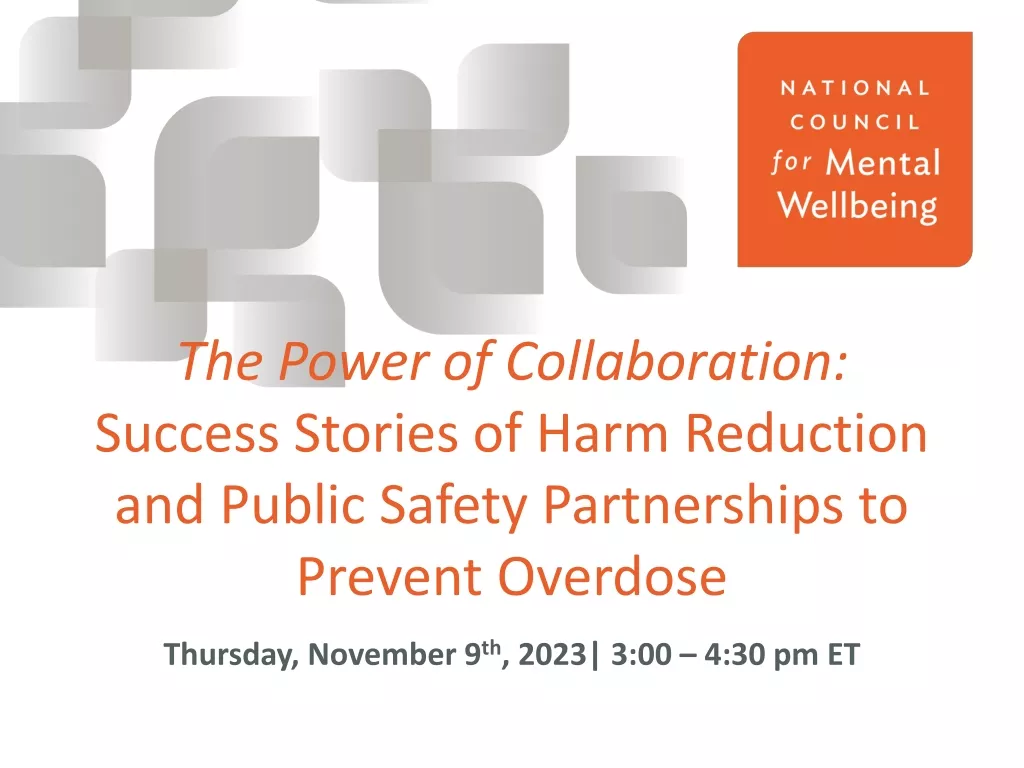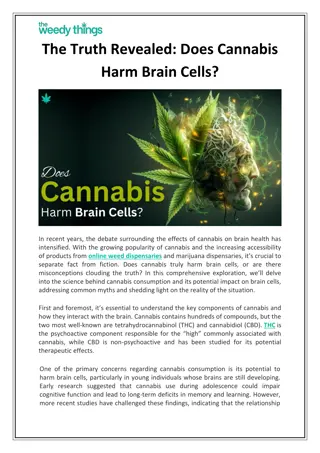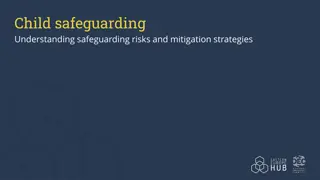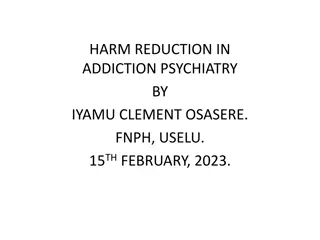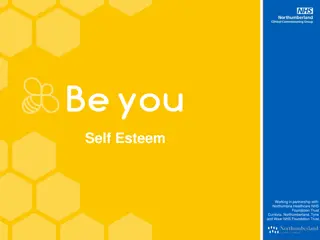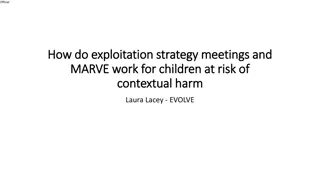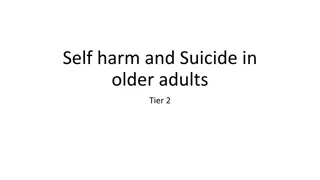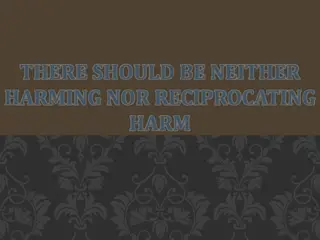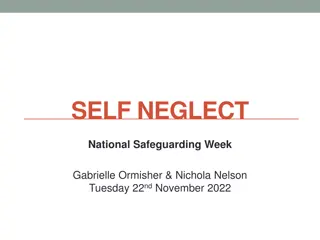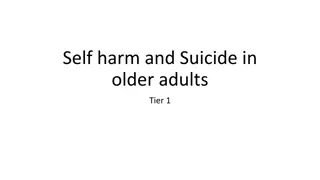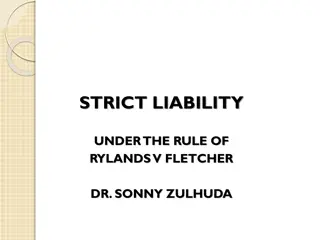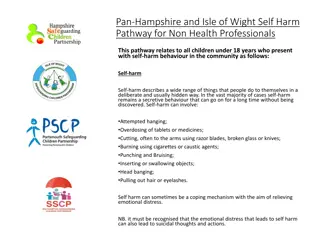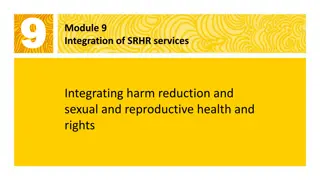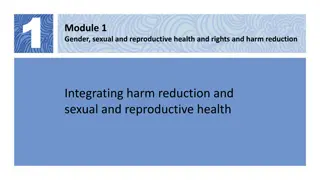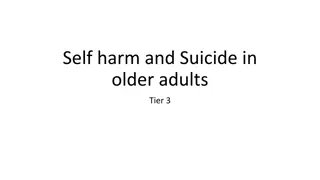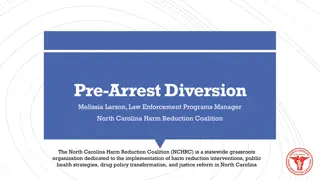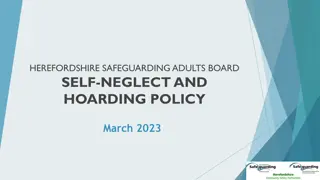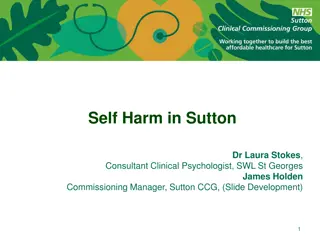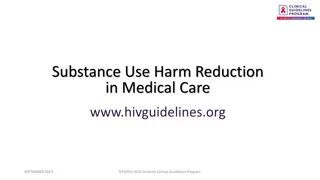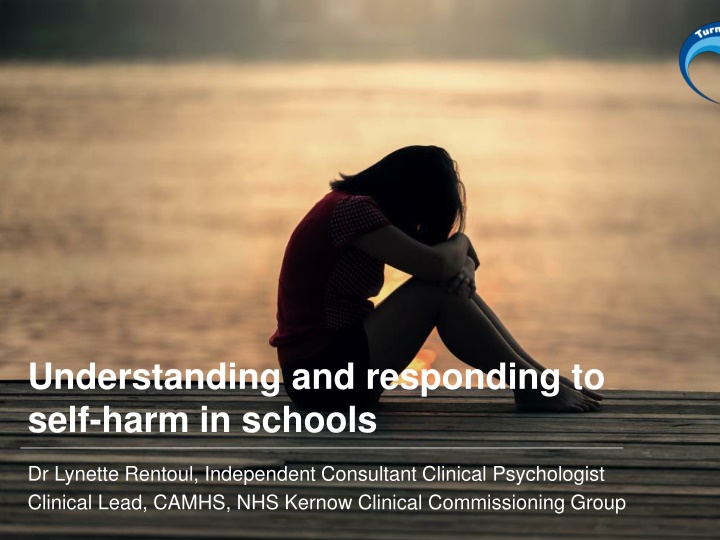
Responding to Self-Harm Behaviors in Schools
Explore the various forms of self-harm behaviors, including self-cutting, hitting, burning, and more among children of different ages. Understand the triggers and risks associated with self-harm, and learn how to effectively address and support individuals engaging in self-harm practices.
Download Presentation

Please find below an Image/Link to download the presentation.
The content on the website is provided AS IS for your information and personal use only. It may not be sold, licensed, or shared on other websites without obtaining consent from the author. If you encounter any issues during the download, it is possible that the publisher has removed the file from their server.
You are allowed to download the files provided on this website for personal or commercial use, subject to the condition that they are used lawfully. All files are the property of their respective owners.
The content on the website is provided AS IS for your information and personal use only. It may not be sold, licensed, or shared on other websites without obtaining consent from the author.
E N D
Presentation Transcript
Understanding and responding to self-harm in schools Dr Lynette Rentoul, Independent Consultant Clinical Psychologist Clinical Lead, CAMHS, NHS Kernow Clinical Commissioning Group
What does self-harm include? Self-harm includes a wide range of behaviours and differences in intensity, severity, complexity and frequency of self-harming behaviours including: Self cutting. Self hitting; self punching. Burning or scalding self. Pulling hair. Picking or scratching one s skin. Self-asphyxiation. Ingesting toxic substances (wide range). Overdose of medication. Fracturing bones. Hitting, kicking walls or hard objects Self-harm may be linked to depression or anxiety or it may start with no previous history of mental health problems
How do younger children harm themselves (among Primary school age children?) Biting, hitting or punching self. Banging one s head on school desk. Harming self by jumping off climbing frame, - placing themselves in danger; highly prone to having accidents; or harm in fighting. Attack themselves rather than expressing their anger or distress directly. Scratching or cutting themselves (e.g. with blade from pencil sharpener). Pulling out hair Self asphyxiation
Who self-harms? Children from all walks of life harm themselves, regardless of their ethnic, religious, cultural, class background (peaks in wealthy and deprived areas). Both boys and girls harm themselves (some differences). Increased risk: suicide or self- harm in family member; low self- esteem; relationship difficulties; family conflict; abuse, neglect, and trauma; isolation; bullying (cyber bullying; homophobic; transgender); mental health problems; domestic violence; periods in care of LA. Children more likely to harm themselves between ages 13- 18 years (but children as young as four can harm themselves, including severe self-harm). 50% of children identified for support in the Mind and Body (MAB) self-harm programme were not known to any agency.
Understanding self-harm Self-harm may be a response to strong feelings and distressing experiences, which are hard to deal with. During adolescence, young people may encounter particularly painful emotional events for the first time. Adolescents who self-harm describe feelings of powerlessness and despair, and say they turn to self-harm to release powerful and frightening emotions, relieve unbearable tension, or gain a fleeting sense of control. Do More Good Than Harm 2006
In the words of a child Self-harm used to be a way of getting rid of the feelings inside me. To get rid of all the hurt, anger and pain that I was feeling. The rush it gave, the sense of feeling better was always short-lived. So short that I was doing it many times I m trying to get my life normal , though for me self-harm is normal. Something that I have always done to mask my feelings in any other way and find talking exceptionally difficult.
Why children self-harm Dealing with intense and painful feelings of distress, rage, frustration, which build up. Self harm provides immediate relief from tension (for those struggling with emotion regulation). Communicating distress, especially for young people who find it difficult to talk about their feelings. Gives child sense has some control in their life, (when they feel they have v limited control in life; feel trapped and helpless). Way to influence others e.g. to elicit care, affection or confirm love from those close to them. Self punishment (in context of low self-esteem). Way to distract from intense emotional pain. May help some YP feel more alive and connected (especially those feeling deadened and numb by history of harm and abuse). Some young people don t know why they harm themselves or understand their triggers. Among children who cannot call upon more healthy ways of coping (limited self regulation skills), becomes habit they cannot break. Some are influenced by powerful peer group.
Some triggers for Self-Harm Stress Family conflict, arguments and violence Friendship and relationship difficulties Loneliness/ isolation Low self esteem Confusion about gender and/or sexual identity Bullying Distressing or frightening thoughts or memories Feeling very low or anxious Unable or difficulty in talking to friends or trusted adult feeling very alone, frustrated or misunderstood
Short videos made by young people Mind and body programme Self-harm awareness day Mind and Body Programme Step Out of the Crowd 1 1 Mind and body programme Remote but not alone
Self-harm increasing across the country The figures for boys are increasing but at a lower rate. It may be harder to recognize self- harm in boys, because it may look superficially like aggression (such as punching wall), where boy is harmed. Number of girls under the age of 18 years treated in hospital after self-harming has nearly doubled compared with 20 years ago. 13,463 last year compared with 7,327 in 1997 The number of girls treated for substance overdose has risen tenfold over 20 years. Self harm reported to GPs increased 68% over last three years. Those self-harming are at greater risk of suicide. Self-harm among children three times more common in girls than boys.
What is driving self-harm among young people? History of adversity, harm and trauma increases self-harm Internal factors include how well child copes with stress and strong feelings - poor capacity to regulate feelings and cope with challenge and stress. Brain development during phases of adolescence (the amygdala increases in size at different rate than the pre-frontal cortex) makes it much harder to regulate strong feelings during height of puberty. Lack of safe, supportive and understanding family environment Increased family pressures (past and ongoing) conflict and DV. School based pressures - including cyber bullying. Relationship pressures - including social media. Identity problems - including gender identity. Contagion among strong peer groups. Impact of lockdown on families and young people
Spotting warning signs of self-harm Changes in eating and sleeping habits. Expressing feelings of failure, uselessness, loss of hope. Increased isolation from family and friends. Talking about self-harm or suicide. Wearing heavy clothes even in warm weather. Poorer level of school attendance. Lowering of school or college grades. Undue interest in toxic substances. Drug or alcohol misuse Risk taking behaviour. Appears more withdrawn or irritable Appear more distressed.
Self-harm and suicide Majority of children who harm themselves are not trying to kill themselves - just coping with feelings. It is not always clear from the severity of the self-harm what the intention of the child is. Self-harming offers opportunity to help children cope with strong feelings and external stressors. It is also a vital opportunity to explore intentions. Sometimes the self-harm can become increasingly dangerous (by intent or accident) and can become real threat to life - requires monitoring (see Healthy Cornwall training programme). Serious self-harm increases risk of suicide
What is helpful when responding to self- harm: be a compassionate and trusted adult Empathic, patient, non- judgemental - listen and care. Reassuring and supportive. Accept that self-harm helps them cope. See the person behind the self- harm - focus on feelings, rather than self-harm - co-regulation. Accept mixed feelings -the young person might hate their self-harm, even though they might need it. Voice concerns you have, listen to the child s views on what they want to happen. Available adult . Show concern for the child s injuries, - compassion shows their body is worth caring about. Recognise how hard it is for child to talk to you it is a big step, it takes courage to discuss self- harm. When they talk they are not alone. Help young person to identify the triggers. Help child find alternatives to self-harm.
What is not helpful when responding to self harm? Don t make assumptions about why the young person is self-harming - each young person is individual. Don t tell the person off or punish or blame them. Don t be judgemental. Don t avoid talking about it, avoiding talking won t stop self-harm, but will leave child feeling alone. Don t be dismissive. Don t try to force them to stop self- harming - they need to want to stop and find help and skills to do this. Don t ask a young person to promise not to self-harm. Don t promise to keep this secret. Don t treat the young person as mad or incapable. This takes away their self-respect and ignores strengths. Panicking and overreacting can be very frightening for children - stay calm and talk and help them cope.
Young peoples views on helpful school approaches Discuss mental heath in PSHE, create ethos of understanding and acceptance - non- stigmatising. Whole school needs to know who first aiders are and make students aware of this. Whole school consistent approach to mental health. Safety plans student led and held by school (may use the MH and Wellbeing Road Map developed by YP Cornwall). Important for students with mental health problems to have updated, shareable records. All school staff aware of what support is available in school - supports consistency. A safe comfortable environment within the school to go to if distressed.
Young peoples views on unhelpful school approaches Stigmatising and inappropriate language (such as attention seeking ; or mocking). Passed off to other services without explanation or compassion ( fobbed off ). Lack of privacy within the school environment for students who self harm. A lack of consistency in approach to self- harm. A stigmatising environment with a lack of mental health awareness.
Young peoples 10 top tips for schools Aware and open approach/ culture to mental health and self-harm across the whole school community. Involve parents where possible and with permission (always notify students before contact is made). Comfortable environment with privacy and safety when dealing with self-harm. A plan for all students with mental health difficulties including self- harm. Teachers awareness of student s needs where appropriate. Have regular check-ins with students known to be struggling (even when they appear OK). Good and consistent communication about self- harm with clear set of procedures. Regular input about mental health in PSHE; embed mental health issues in all subjects. Have a clear plan of action for young people struggling and in crisis (student led). Take self-harm seriously (but also with appropriate humour and humanity)!
Cornwall I-Thrive framework for self- harm: Pathways of support and treatment Getting help from primary mental health; BLOOM; MAB; voluntary sector; YPC young people Cornwall Youth support Wellbeing practitioners Support and guidance in schools; TIS Ed. Psych PH written guidance Bloom networks Coping and advice Getting help Getting more help Risk support Managing risk; social care and CAMHS; safety plans Getting more help; specialist CAMHS/CAP
Support for children who self-harm: links with other agencies I-Thrive Framework supports mental health pathways across all levels of care and treatment -from early intervention in schools and community to highly Specialist CAMHS Written Guidance provided by Public Health and local CCG Trauma Informed Schools (TIS), and Young People Cornwall (HOV) provide support in schools and community Youth support services and Wellbeing practitioners Mind and Body programme (MAB) gives support in schools for pupils who self-harm. Bloom networks across the county provide advice and guidance for schools, primary health and social care. TIS provides support in schools. MHST provide help and support in Primary Schools Social Care provide support in relation to Safeguarding & risk

